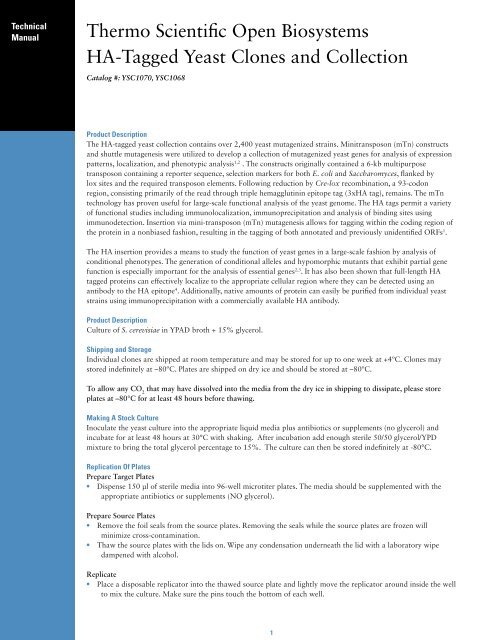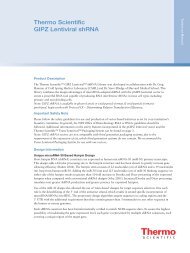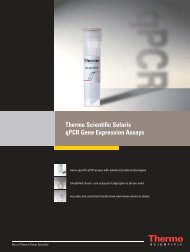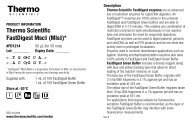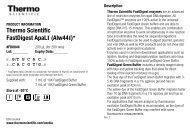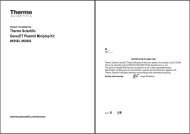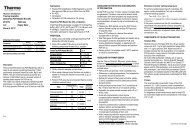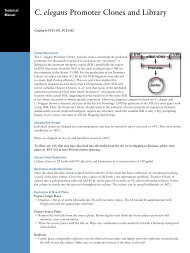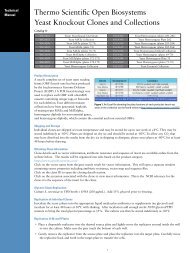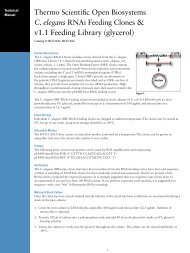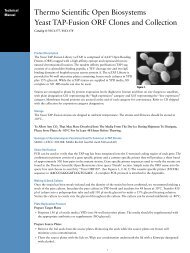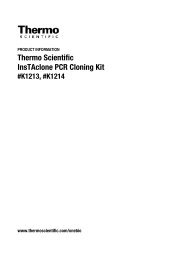HA Tagged Yeast Clones and Collection - Thermo Scientific
HA Tagged Yeast Clones and Collection - Thermo Scientific
HA Tagged Yeast Clones and Collection - Thermo Scientific
You also want an ePaper? Increase the reach of your titles
YUMPU automatically turns print PDFs into web optimized ePapers that Google loves.
Technical<br />
Manual<br />
<strong>Thermo</strong> <strong>Scientific</strong> Open Biosystems<br />
<strong>HA</strong>-<strong>Tagged</strong> <strong>Yeast</strong> <strong>Clones</strong> <strong>and</strong> <strong>Collection</strong><br />
Catalog #: YSC1070, YSC1068<br />
Product Description<br />
The <strong>HA</strong>-tagged yeast collection contains over 2,400 yeast mutagenized strains. Minitransposon (mTn) constructs<br />
<strong>and</strong> shuttle mutagenesis were utilized to develop a collection of mutagenized yeast genes for analysis of expression<br />
patterns, localization, <strong>and</strong> phenotypic analysis 1,2 . The constructs originally contained a 6-kb multipurpose<br />
transposon containing a reporter sequence, selection markers for both E. coli <strong>and</strong> Saccharomyces, flanked by<br />
lox sites <strong>and</strong> the required transposon elements. Following reduction by Cre-lox recombination, a 93-codon<br />
region, consisting primarily of the read through triple hemagglutinin epitope tag (3x<strong>HA</strong> tag), remains. The mTn<br />
technology has proven useful for large-scale functional analysis of the yeast genome. The <strong>HA</strong> tags permit a variety<br />
of functional studies including immunolocalization, immunoprecipitation <strong>and</strong> analysis of binding sites using<br />
immunodetection. Insertion via mini-transposon (mTn) mutagenesis allows for tagging within the coding region of<br />
the protein in a nonbiased fashion, resulting in the tagging of both annotated <strong>and</strong> previously unidentified ORFs 1 .<br />
The <strong>HA</strong> insertion provides a means to study the function of yeast genes in a large-scale fashion by analysis of<br />
conditional phenotypes. The generation of conditional alleles <strong>and</strong> hypomorphic mutants that exhibit partial gene<br />
function is especially important for the analysis of essential genes 2,3 . It has also been shown that full-length <strong>HA</strong><br />
tagged proteins can effectively localize to the appropriate cellular region where they can be detected using an<br />
antibody to the <strong>HA</strong> epitope 4 . Additionally, native amounts of protein can easily be purified from individual yeast<br />
strains using immunoprecipitation with a commercially available <strong>HA</strong> antibody.<br />
Product Description<br />
Culture of S. cerevisiae in YPAD broth + 15% glycerol.<br />
Shipping <strong>and</strong> Storage<br />
Individual clones are shipped at room temperature <strong>and</strong> may be stored for up to one week at +4ºC. <strong>Clones</strong> may<br />
stored indefinitely at –80ºC. Plates are shipped on dry ice <strong>and</strong> should be stored at –80ºC.<br />
To allow any CO 2 that may have dissolved into the media from the dry ice in shipping to dissipate, please store<br />
plates at –80°C for at least 48 hours before thawing.<br />
Making A Stock Culture<br />
Inoculate the yeast culture into the appropriate liquid media plus antibiotics or supplements (no glycerol) <strong>and</strong><br />
incubate for at least 48 hours at 30°C with shaking. After incubation add enough sterile 50/50 glycerol/YPD<br />
mixture to bring the total glycerol percentage to 15%. The culture can then be stored indefinitely at -80°C.<br />
Replication Of Plates<br />
Prepare Target Plates<br />
• Dispense 150 μl of sterile media into 96-well microtiter plates. The media should be supplemented with the<br />
appropriate antibiotics or supplements (NO glycerol).<br />
Prepare Source Plates<br />
• Remove the foil seals from the source plates. Removing the seals while the source plates are frozen will<br />
minimize cross-contamination.<br />
• Thaw the source plates with the lids on. Wipe any condensation underneath the lid with a laboratory wipe<br />
dampened with alcohol.<br />
Replicate<br />
• Place a disposable replicator into the thawed source plate <strong>and</strong> lightly move the replicator around inside the well<br />
to mix the culture. Make sure the pins touch the bottom of each well.<br />
1
• Gently remove the replicator from the source plate <strong>and</strong> place the replicator into the target plate. Carefully<br />
move the replicator back <strong>and</strong> forth in the target plate to transfer the cells.<br />
• Discard the replicator.<br />
• Place the lids back on the plates.<br />
• Repeat this process until all plates have been replicated.<br />
• Return the source plates to the –80ºC freezer.<br />
• Place the inoculated target plates in a 30ºC incubator. Incubate the plates for at least<br />
• 48 hours.<br />
• Seal the source plates, being careful to avoid cross-contamination.<br />
Strain Verification<br />
A PCR reaction using one gene specific <strong>and</strong> one<br />
3x<strong>HA</strong>-tag specific primer should yield a product<br />
with a known size, since the 3x<strong>HA</strong>-tag insertion<br />
site is unique for each strain.<br />
3x<strong>HA</strong> Tag Sequence<br />
GCGGCCGTTTACCCATACGATGTTCCTGAC TATGCGGGCTATCCCTATGACGTCCCGGAC<br />
TATGCAGGATCCTATCCATATGACGTTCCAG ATTACGCTCCGGCCGCC<br />
References<br />
1 P. Ross-Macdonald, et.al., Nature 402, 413 (1999)<br />
2 P. Ross-Macdonald, A. Sheehan, G.S. Roeder, <strong>and</strong> M. Snyder, Proc. Natl. Acad. Sci. U.S.A. 94, 190 (1997).<br />
3 Kumar, A., des Etages, S.A., Coelho, P.S.R., Roeder, G.S., <strong>and</strong> Snyder, M. Methods Enzymol 328, 550 (2000).<br />
4 A. Kumar, et.al., Genes & Development 16, 707 (2002).<br />
FAQS/Troubleshooting<br />
What is the size of <strong>HA</strong>-tag in kDa?<br />
The size of <strong>HA</strong>-tag (3x<strong>HA</strong> in our <strong>HA</strong>-tagged strains) is approximately 3kDa.<br />
Useful Websites<br />
Public access to the resulting gene data, protocols, <strong>and</strong><br />
publications is available at the Yale Genome Analysis Center.<br />
http://ygac.med.yale.edu/triples/triples.htm<br />
Are the <strong>HA</strong>-tagged yeast diploid?<br />
Yes, the <strong>HA</strong>-tagged yeast are diploid; (BY4741 strain), but the tag may only be on one allele. The yeast Y800<br />
genotype is as follows:<br />
[MATa leu2-D98cry1R/MATalpha leu2-D98CRY1 ade2-101 HIS3/ade2-101 his3-D200 ura3-52 caniR/ura3-<br />
52CAN1 lys2-801/lys2-801 CYH2/cyh2R trp1-1/TRP1 Cir0] carrying pGAL-cre (amp,ori, CEN, LEU2)5<br />
How can I find the <strong>HA</strong>-tagged insertion site?<br />
The insertion site can be found in the details section on our internal query. The number given is the amino acid<br />
location where the tag was inserted.<br />
For answers to questions that are not addressed here, please email technical support at<br />
openbiosystems@thermofisher.com with your question, your sales order or purchase order number <strong>and</strong> the catalog<br />
number or clone ID of the construct or collection with which you are having trouble.<br />
3<br />
Contact Information<br />
Technical Support<br />
Tel: 1.888.412.2225<br />
Fax: 1.256.704.4849<br />
openbiosystems@<br />
thermofisher.com<br />
© 2010 <strong>Thermo</strong> Fisher<br />
<strong>Scientific</strong> Inc. All rights<br />
reserved. Trademarks<br />
are the property of their<br />
respective owners. All<br />
other trademarks are<br />
the property of <strong>Thermo</strong><br />
Fisher <strong>Scientific</strong> Inc.<br />
<strong>and</strong> its subsidiaries. For<br />
Research Use Only.


